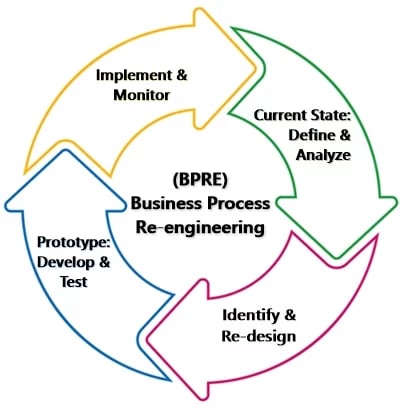The Power of Business Process Re-engineering (BPR) in the Digital Age
This blog post introduces the reader to the concept of Business Process Re-engineering (BPR) in the Digital Age


Business Process Re-engineering (BPR) is a strategic management approach that involves the radical rethinking and redesigning of core business processes to achieve significant improvements in efficiency, effectiveness, and agility. In today's digital age, BPR has become more crucial than ever for organizations seeking to stay competitive and thrive in a rapidly changing business landscape.
Imagine your business as an old factory, with outdated machinery and inefficient workflows. BPR is like tearing down that old factory and building a sleek, modern one, optimized for the digital era. It involves examining every aspect of your business processes, from the way tasks are performed to the technology and systems used, and reimagining them to better align with your organization's goals and objectives.
One of the key drivers behind BPR is the need to adapt to the ever-evolving digital landscape. Technology has transformed the way we do business, and organizations that fail to embrace digital transformation risk being left behind. BPR enables businesses to leverage technology and automation to streamline processes, eliminate bottlenecks, and improve overall efficiency.
However, BPR is not just about implementing the latest technology or automating existing processes. It requires a fundamental shift in mindset and a willingness to challenge the status quo. It involves questioning why things are done a certain way and exploring alternative approaches that can drive better results.
So, what exactly does BPR entail? It's a five-step journey:
Vision and Rethinking: Start by defining your desired future state and questioning every aspect of your current processes. Challenge assumptions, embrace new technologies, and be bold!
Analysis and Redesign: Deep dive into your existing processes, identifying bottlenecks, redundancies, and opportunities for improvement. Data analysis, stakeholder interviews, and process mapping are your allies here.
Prototyping and Implementation: Don't just plan, test! Build pilots and prototypes of your redesigned processes to gather feedback and refine your approach before full-scale implementation.
Monitoring and Evaluation: Change is a journey, not a destination. Continuously monitor the performance of your new processes, adapt as needed, and celebrate successes along the way.
Cultural Transformation: BPR is not just about technology or processes; it's about changing mindsets. Foster a culture of continuous improvement, embrace learning, and empower employees to be change agents.
But why embark on this ambitious journey? The benefits are undeniable:
Increased Efficiency: Streamlined processes lead to faster turnaround times, reduced costs, and improved resource utilization.
Enhanced Customer Satisfaction: Reimagined processes deliver a better customer experience, boosting loyalty and brand reputation.
Competitive Advantage: Agility and innovation become your weapons, allowing you to adapt to changing market demands and outpace the competition.
Improved Employee Engagement: Empowering employees to participate in process improvement fosters ownership and motivation.
Of course, BPR isn't without its challenges:
Cost and Effort: BPR requires significant investment in time, resources, and expertise.
Change Management: Shifting mindsets and overcoming resistance to change can be difficult.
Risk of Failure: Embracing radical change comes with the possibility of setbacks and unforeseen issues.
But with careful planning, strong leadership, and a commitment to continuous improvement, BPR can be a game-changer for your business.
Here are some inspiring examples of successful BPR implementations:
Ford Motor Company: BPR helped Ford reduce production times by 50% and improve quality significantly.
Motorola: BPR initiatives led to a 99% reduction in defects and a 30% increase in customer satisfaction.
Citibank: BPR streamlined loan processing, reducing turnaround times from weeks to days.
Ready to embark on your own BPR journey? Here are some key tips:
Start small: Choose a specific process with high impact potential and manageable complexity for your first BPR project.
Build a strong team: Assemble a team with the expertise, leadership, and change management skills needed to guide the process.
Communicate effectively: Keep everyone informed about the BPR initiative, its goals, and expected outcomes.
Celebrate successes: Recognize and reward teams for their achievements throughout the BPR journey.
